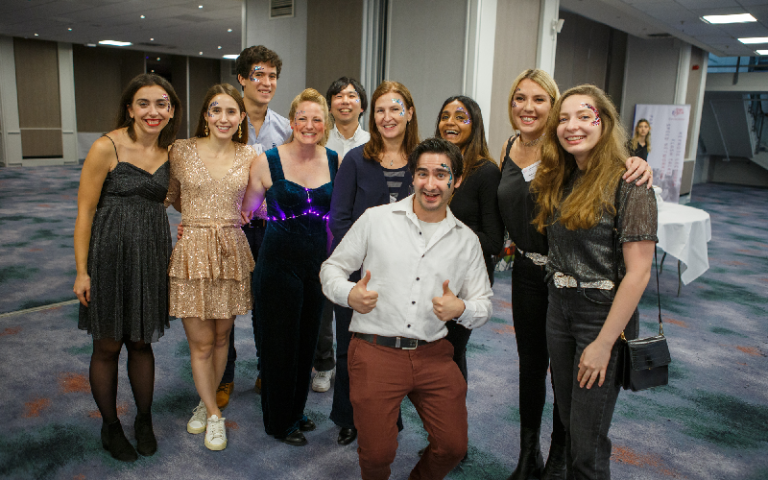We go behind the scenes in Prof Karen Duff’s lab to hear about their research, the importance of teamwork and moving to Grays Inn Road

The Duff lab at the UK DRI’s annual conference, Connectome.
Prof Karen Duff is the Centre Director of the UK Dementia Research Institute at UCL. Currently, her lab is based at the Cruciform building and is made up of 10 people, including five post-docs and five PhD students.
Intraneuronal neurofibrillary tangles (NFTs), which consist of pathological accumulations of the protein tau, are a hallmark of several neurodegenerative diseases, including Alzheimer’s Disease and frontotemporal dementia. Collectively, we refer to this group of diseases as tauopathies. The main focus of our lab is understanding the causes and consequences of abnormal tau accumulation and the propagation of tauopathy. Ultimately, we hope that our research will help identify druggable targets that will allow us to prevent, stop, and/or slow down the progression of these diseases.
As part of this larger aim, we all work on individual projects hoping to address some of the key questions in the field. This includes identifying why certain neurons are more vulnerable than others to tau aggregation, how we can promote the clearance of these aberrant protein aggregates, and how risk factors, genetic modifiers, or mutations in the tau gene may impact the biological mechanisms behind tauopathies. We are also very interested in better understanding the mechanisms behind tau spread both between individual neurons and brain regions.

Sumi Bez in the Duff Lab
We also strive to work on the best models of disease. While HEK or SH-SY5Y cells overexpressing your protein of interest are a great way to quickly understand the function of your target, it is crucial to also work with more sophisticated models.
Together with collaborators in the USA, we have developed and published on a direct conversion of fibroblasts into neurons using micro-RNA’s (mINS). mINS have a significant advantage over other commonly used models such as iPSC’s, as they maintain their epigentic age signature and express all six isoforms of tau (Capano et al., 2022). Currently, we work with cell lines taken from health donors and donors which have aberrant mutations in the MAPT (tau) gene.
With collaborators in Japan, we have also developed and characterised a new tauopathy mouse model. As the phenotypic profile of many of the current tauopathy models is based on the non-physiological expression of a transgene, which leads to massive overexpression and expression in irrelevant brain areas at inappropriate times, our collaborators at RIKEN have generated a new human tau knock-in mouse model. In these mice, the mouse MAPT gene was replaced with the human MAPT gene, expressing all 6 isoforms of tau under the endogenous mouse tau promoter on chromosome 11 at physiologically relevant levels.
“The Duff lab really works together as a team, and we have all become good friends throughout our time here. This also provides the perfect environment for us students to graduate from ‘baby scientist’, a term lovingly coined by our post-docs, to ‘expert adult’.
We all love discussing our ideas with each other and sharing our findings whether this be at our weekly lab meetings, lunch time, or even at the pub. Our lab has a very collaborative atmosphere, where we celebrate each other’s success and help one another when needed. The Duff lab really works together as a team, and we have all become good friends throughout our time here. This also provides the perfect environment for us students to graduate from ‘baby scientist’, a term lovingly coined by our post-docs, to ‘expert adult’.

Saisha Patel in the Duff Lab
“We believe collaborations are very important for the advancement of research, and the new Gray’s Inn Road building will provide us with the perfect opportunity to collaborate more directly with clinicians at the forefront of neurodegenerative disease
As well as being part of an incredibly supportive network within the UK DRI, we are proud to say that we also work with a number of collaborators across UCL, the UK, and worldwide. Collaborations allow us to maximise our resources and efficiently address our research questions. Two of these multi-lab, multi-institute projects are: to understand the relationship between tauopathy spread in the hippocampal formation and deficits in spatial navigation in both mouse models and humans with Alzheimer's disease; and to identify the role of genetic modifiers and risk factors in disease diversity.
We believe collaborations are very important for the advancement of research, and the new Gray’s Inn Road building will provide us with the perfect opportunity to collaborate more directly with clinicians at the forefront of neurodegenerative diseases. We are very excited about the new building and believe that it will enable a more interdisciplinary approach and provide a more complete picture of disease, from bench to bedside. It will also be a great opportunity to have teams from different disciplines within one building to build a cohesive community all working together towards the main goal of providing treatments, and ultimately cures, for neurodegenerative diseases.
 Close
Close

